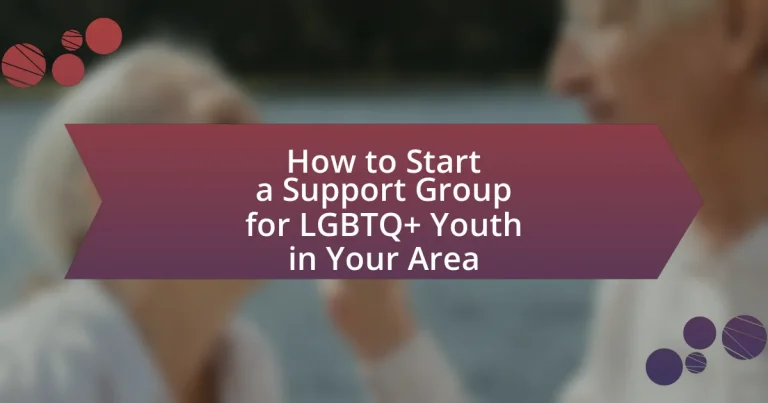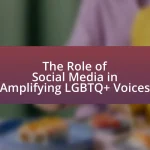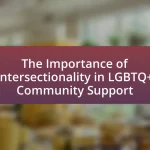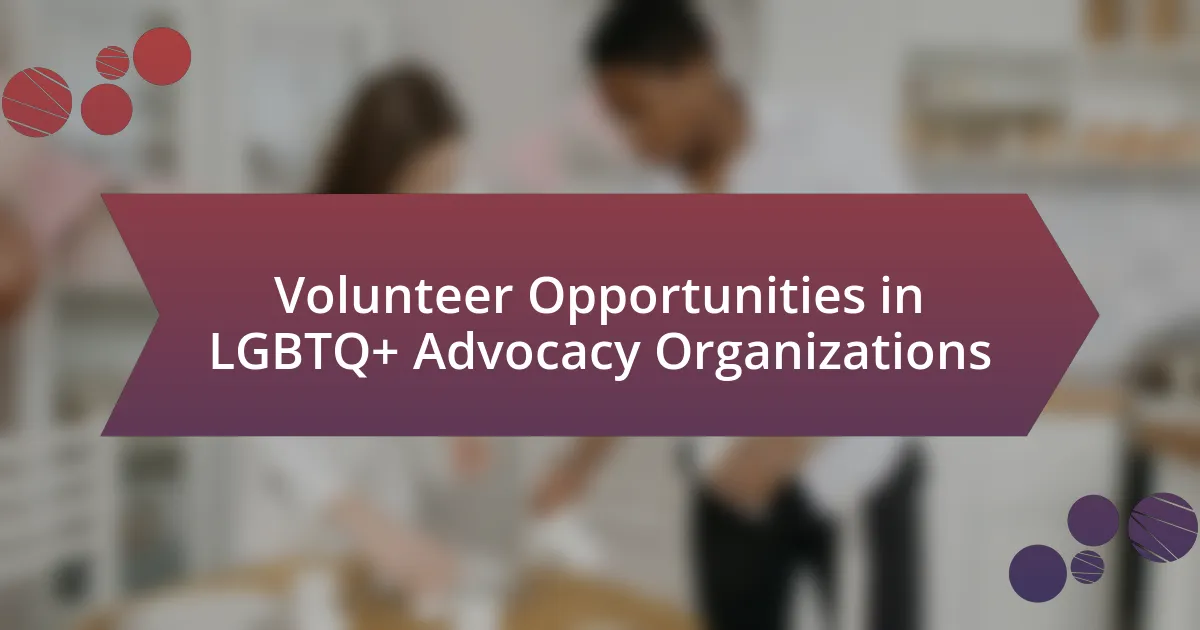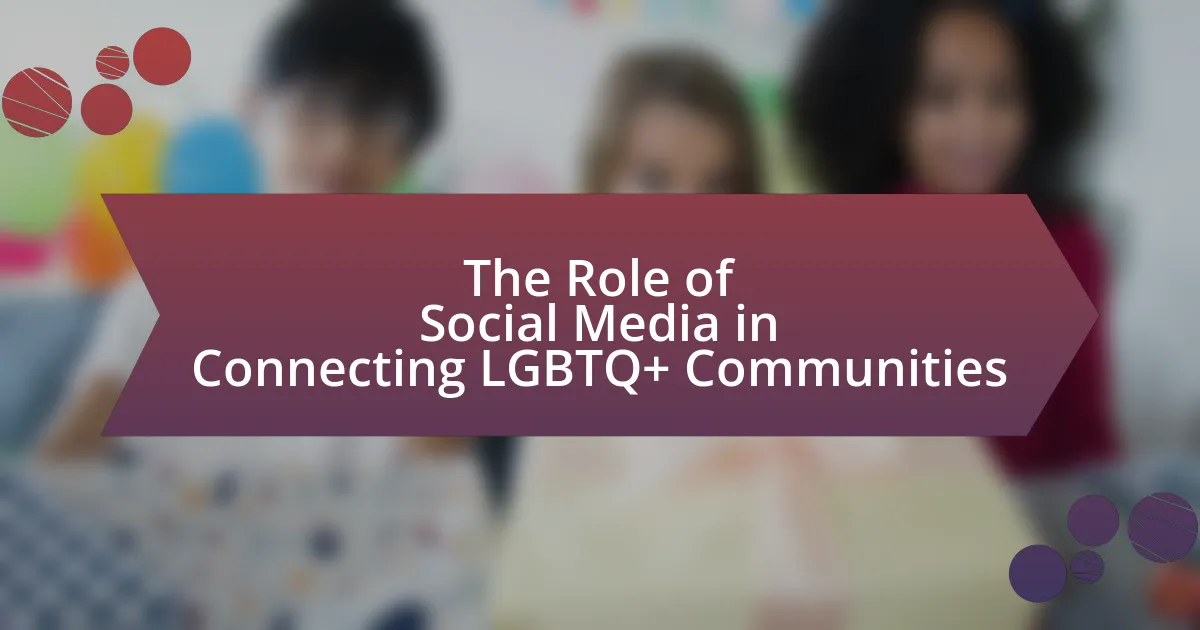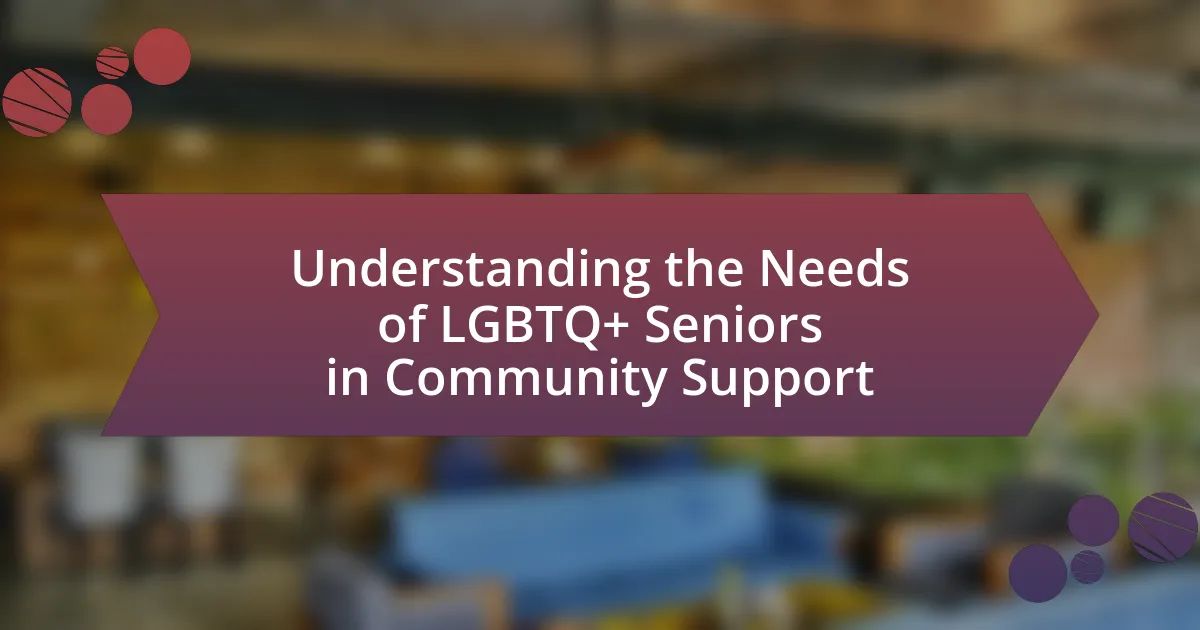A support group for LGBTQ+ youth is a vital resource that provides a safe and inclusive environment for young individuals to share their experiences, seek guidance, and receive emotional support. This article outlines the importance of establishing such groups, detailing the benefits they offer, including improved mental health outcomes, reduced feelings of isolation, and enhanced resilience. It also discusses the steps involved in starting a support group, identifying the needs of LGBTQ+ youth, and best practices for creating a supportive and sustainable environment. Key topics include the roles of facilitators, the significance of confidentiality, and the incorporation of educational resources and social activities to foster community and belonging among members.

What is a Support Group for LGBTQ+ Youth?
A support group for LGBTQ+ youth is a safe and inclusive space where young individuals who identify as LGBTQ+ can share their experiences, seek guidance, and receive emotional support from peers and facilitators. These groups often focus on issues such as identity, acceptance, mental health, and navigating societal challenges. Research indicates that participation in support groups can significantly improve mental health outcomes for LGBTQ+ youth, reducing feelings of isolation and increasing resilience. For instance, a study published in the Journal of Youth and Adolescence found that LGBTQ+ youth involved in support groups reported higher levels of self-esteem and lower levels of depression compared to those who did not participate.
How does a support group benefit LGBTQ+ youth?
A support group benefits LGBTQ+ youth by providing a safe space for them to share experiences and feelings, fostering a sense of belonging and acceptance. This environment helps reduce feelings of isolation and anxiety, which are prevalent among LGBTQ+ youth; studies indicate that such groups can significantly improve mental health outcomes. For instance, research published in the Journal of Youth and Adolescence found that participation in support groups correlates with lower rates of depression and higher self-esteem among LGBTQ+ individuals.
What emotional support do these groups provide?
Support groups for LGBTQ+ youth provide emotional support by creating a safe space for individuals to express their feelings, share experiences, and connect with peers who understand their challenges. These groups facilitate open discussions about identity, acceptance, and mental health, which can significantly reduce feelings of isolation and anxiety. Research indicates that participation in such groups can lead to improved self-esteem and emotional resilience among LGBTQ+ youth, as they receive validation and encouragement from others facing similar situations.
How do support groups foster community and belonging?
Support groups foster community and belonging by providing a safe space for individuals to share experiences and connect with others facing similar challenges. This environment encourages open communication, empathy, and mutual support, which are essential for building trust and relationships among members. Research indicates that participation in support groups can lead to improved mental health outcomes, as individuals feel less isolated and more understood, reinforcing their sense of belonging within the group. For instance, a study published in the Journal of Community Psychology found that support groups significantly enhance social connectedness and reduce feelings of loneliness among participants.
Why is it important to create a support group for LGBTQ+ youth?
Creating a support group for LGBTQ+ youth is important because it provides a safe space for individuals to express themselves and connect with peers who share similar experiences. This connection can significantly reduce feelings of isolation and loneliness, which are prevalent among LGBTQ+ youth. Research indicates that LGBTQ+ youth are at a higher risk for mental health issues, with studies showing that they experience higher rates of depression and anxiety compared to their heterosexual peers. A support group can offer emotional support, resources, and a sense of community, which are crucial for their well-being and development.
What challenges do LGBTQ+ youth face that support groups can address?
LGBTQ+ youth face several challenges that support groups can effectively address, including social isolation, mental health issues, and discrimination. Social isolation often stems from rejection by peers and family, leading to feelings of loneliness and low self-esteem. Mental health issues, such as anxiety and depression, are prevalent among LGBTQ+ youth, with studies indicating that they are at a higher risk for suicidal thoughts compared to their heterosexual peers. Discrimination, whether in schools or communities, can manifest as bullying or lack of acceptance, further exacerbating these challenges. Support groups provide a safe space for LGBTQ+ youth to connect, share experiences, and receive emotional support, which can significantly improve their mental well-being and resilience against societal pressures.
How can support groups promote mental health and well-being?
Support groups can promote mental health and well-being by providing a safe space for individuals to share experiences and receive emotional support. This environment fosters a sense of belonging and reduces feelings of isolation, which are critical for mental health. Research indicates that participation in support groups can lead to improved psychological well-being, as evidenced by a study published in the Journal of Clinical Psychology, which found that individuals who engaged in support groups reported lower levels of depression and anxiety. Additionally, support groups facilitate the exchange of coping strategies and resources, empowering members to manage their mental health more effectively.

How can you start a support group for LGBTQ+ youth?
To start a support group for LGBTQ+ youth, first identify a safe and welcoming space where meetings can occur, such as community centers or schools. Next, recruit interested participants through local LGBTQ+ organizations, social media, or schools, ensuring to promote inclusivity and confidentiality. Establish clear guidelines for the group, focusing on respect and support, and consider involving trained facilitators to guide discussions. Research indicates that support groups can significantly improve mental health outcomes for LGBTQ+ youth, as highlighted in studies by the Trevor Project, which found that LGBTQ+ youth who engage in supportive environments report lower rates of depression and suicidal ideation.
What steps are involved in establishing a support group?
To establish a support group, first identify the specific needs of the LGBTQ+ youth community in your area. This involves conducting surveys or interviews to understand their challenges and preferences. Next, recruit a core group of committed individuals who share a passion for supporting LGBTQ+ youth, ensuring diversity in experiences and backgrounds. Following this, secure a safe and accessible meeting space that fosters a welcoming environment. Develop a clear mission statement and set of guidelines to outline the group’s purpose and expectations. Promote the support group through local schools, community centers, and social media to reach potential members. Finally, plan regular meetings and activities that encourage open dialogue, peer support, and resource sharing, adapting the approach based on feedback from participants.
How do you identify the needs of LGBTQ+ youth in your area?
To identify the needs of LGBTQ+ youth in your area, conduct surveys and focus groups specifically targeting this demographic. These methods allow for direct feedback on their experiences, challenges, and support requirements. For instance, a study by the Human Rights Campaign found that 70% of LGBTQ+ youth reported feeling isolated, highlighting the importance of understanding their social and emotional needs. Engaging with local LGBTQ+ organizations can also provide insights into prevalent issues and resources available, ensuring that the support group addresses the most pressing concerns effectively.
What resources are necessary to start a support group?
To start a support group for LGBTQ+ youth, essential resources include a safe meeting space, trained facilitators, outreach materials, and community partnerships. A safe meeting space ensures confidentiality and comfort, which is crucial for participants. Trained facilitators provide guidance and support, fostering a positive environment. Outreach materials, such as flyers and social media posts, help attract participants and inform the community. Community partnerships with local organizations can provide additional support and resources, enhancing the group’s effectiveness. These elements are vital for establishing a successful and sustainable support group.
Who should be involved in the support group?
The support group should involve LGBTQ+ youth, their allies, mental health professionals, and community advocates. LGBTQ+ youth are the primary participants, as they are the individuals seeking support and connection. Allies, including friends and family members, can provide additional understanding and encouragement. Mental health professionals contribute expertise in emotional well-being and coping strategies, ensuring a safe environment. Community advocates can help facilitate discussions and provide resources, enhancing the group’s effectiveness. This diverse involvement fosters a supportive atmosphere that addresses the unique challenges faced by LGBTQ+ youth.
What roles can facilitators and volunteers play?
Facilitators and volunteers play crucial roles in support groups for LGBTQ+ youth by providing guidance, creating a safe environment, and fostering community engagement. Facilitators lead discussions, ensure that all voices are heard, and help navigate sensitive topics, which is essential for building trust among participants. Volunteers support facilitators by assisting with logistics, organizing activities, and offering peer support, which enhances the overall experience for youth. Research indicates that effective facilitation and volunteer involvement significantly improve group cohesion and participant satisfaction, as evidenced by studies showing that structured support environments lead to better mental health outcomes for LGBTQ+ individuals.
How can you engage LGBTQ+ youth in the planning process?
Engaging LGBTQ+ youth in the planning process can be effectively achieved by creating inclusive spaces that encourage their active participation. This can be done by organizing focus groups where LGBTQ+ youth can share their experiences and ideas, ensuring that their voices are heard and valued. Research indicates that youth involvement in decision-making processes leads to more relevant and effective outcomes, as seen in studies conducted by the Human Rights Campaign, which highlight the importance of youth input in shaping supportive environments. Additionally, providing training on leadership and advocacy can empower LGBTQ+ youth, equipping them with the skills needed to contribute meaningfully to the planning process.
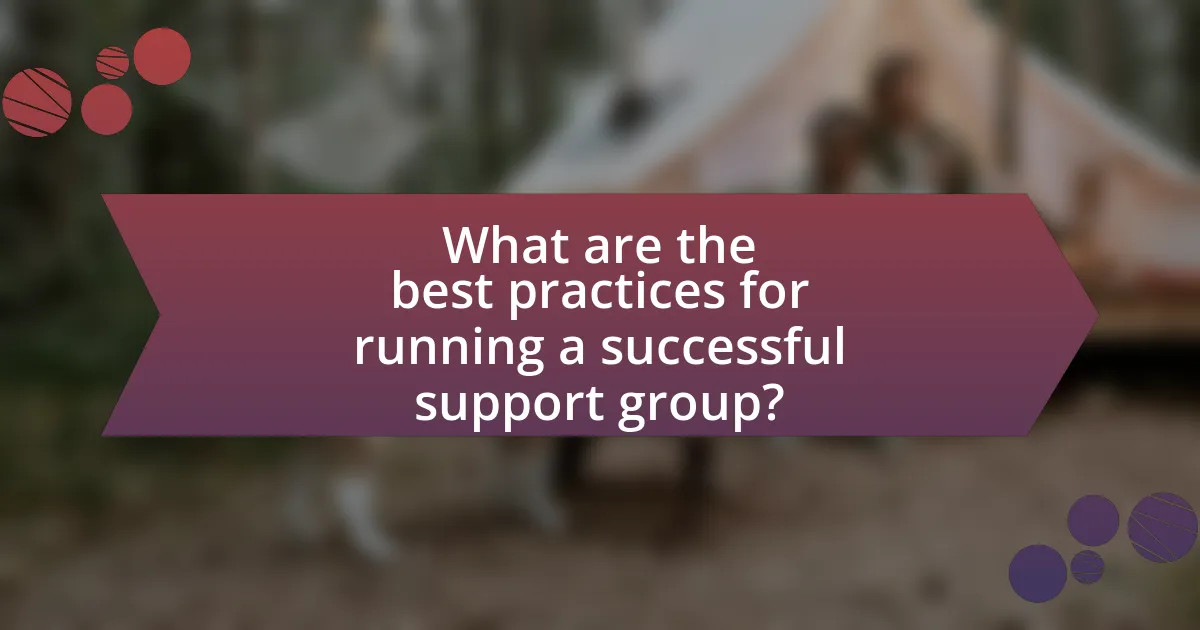
What are the best practices for running a successful support group?
The best practices for running a successful support group include establishing clear goals, creating a safe and inclusive environment, and facilitating open communication among members. Clear goals help participants understand the purpose of the group, which can enhance engagement and focus. A safe and inclusive environment fosters trust, allowing members to share their experiences without fear of judgment. Facilitating open communication encourages active participation and ensures that all voices are heard, which is particularly important in support groups for LGBTQ+ youth, as studies show that supportive peer interactions can significantly improve mental health outcomes. Additionally, regular feedback from participants can help adapt the group’s approach to better meet their needs, further contributing to the group’s success.
How can you create a safe and inclusive environment?
To create a safe and inclusive environment for LGBTQ+ youth, establish clear guidelines that promote respect and acceptance among all participants. These guidelines should explicitly prohibit discrimination, harassment, and bullying, fostering a culture of support. Research indicates that inclusive environments significantly improve mental health outcomes for LGBTQ+ individuals; for instance, a study published in the Journal of Youth and Adolescence found that supportive peer relationships can reduce feelings of isolation and depression among LGBTQ+ youth. Additionally, providing training for facilitators on LGBTQ+ issues and cultural competency enhances the group’s ability to address the unique challenges faced by its members, further solidifying a safe space.
What guidelines should be established for group discussions?
Guidelines for group discussions should include establishing a safe and respectful environment, encouraging active listening, and promoting equal participation. A safe environment ensures that all members feel comfortable sharing their thoughts without fear of judgment, which is crucial for LGBTQ+ youth who may face stigma. Active listening fosters understanding and empathy among participants, allowing for deeper connections and support. Equal participation ensures that every voice is heard, preventing dominant personalities from overshadowing quieter members, which is essential for building a supportive community. These guidelines are supported by research indicating that structured discussions lead to more effective communication and stronger group cohesion.
How can confidentiality be maintained within the group?
Confidentiality within the group can be maintained by establishing clear guidelines that all members agree to follow. These guidelines should include a commitment to not disclose any personal information shared during meetings, ensuring that discussions remain private. Additionally, implementing a sign-in sheet that does not require full names can help protect identities. Research indicates that confidentiality is crucial for creating a safe environment, as it encourages open communication and trust among participants. A study by the American Psychological Association highlights that confidentiality fosters a sense of security, which is essential for effective support in group settings.
What activities can enhance the support group experience?
Engaging activities that can enhance the support group experience include structured discussions, creative expression sessions, and community-building exercises. Structured discussions allow participants to share their experiences and feelings in a safe environment, fostering connection and understanding. Creative expression sessions, such as art or writing workshops, enable individuals to express their identities and emotions, which can be therapeutic and empowering. Community-building exercises, like team-building games or group outings, help strengthen relationships among members, creating a sense of belonging and support. Research indicates that support groups that incorporate diverse activities report higher satisfaction and engagement levels among participants, enhancing the overall effectiveness of the group.
How can you incorporate educational resources and workshops?
Incorporating educational resources and workshops into a support group for LGBTQ+ youth can be achieved by collaborating with local organizations that specialize in LGBTQ+ issues and youth education. These organizations often provide training materials, guest speakers, and workshops tailored to the needs of LGBTQ+ youth, which can enhance the group’s educational offerings. For instance, partnering with organizations like GLSEN or The Trevor Project can provide access to evidence-based resources and curricula designed to foster understanding and support for LGBTQ+ issues. Additionally, hosting workshops on topics such as mental health, identity exploration, and advocacy can empower youth and create a safe space for discussion. Research indicates that educational workshops can significantly improve knowledge and awareness among participants, leading to better support networks and community engagement.
What social activities can help build connections among members?
Social activities that can help build connections among members include group discussions, team-building exercises, and social outings. Group discussions foster open communication and allow members to share experiences, while team-building exercises encourage collaboration and trust. Social outings, such as movie nights or community events, provide informal settings for members to bond and create lasting friendships. Research indicates that shared experiences enhance group cohesion, making these activities effective in strengthening connections among participants.
What tips can help ensure the sustainability of your support group?
To ensure the sustainability of your support group, establish a clear mission and vision that resonates with members. A defined purpose fosters commitment and guides activities, making it easier to attract and retain participants. Regularly assess the needs of the group through surveys or discussions, allowing for adjustments that keep the group relevant and engaging. Additionally, create a diverse leadership team to bring varied perspectives and skills, which enhances decision-making and outreach efforts. Financial sustainability can be achieved by exploring grants, fundraising events, and partnerships with local organizations, ensuring resources are available for ongoing activities. Research indicates that support groups with structured leadership and clear objectives have higher retention rates, reinforcing the importance of these strategies.
